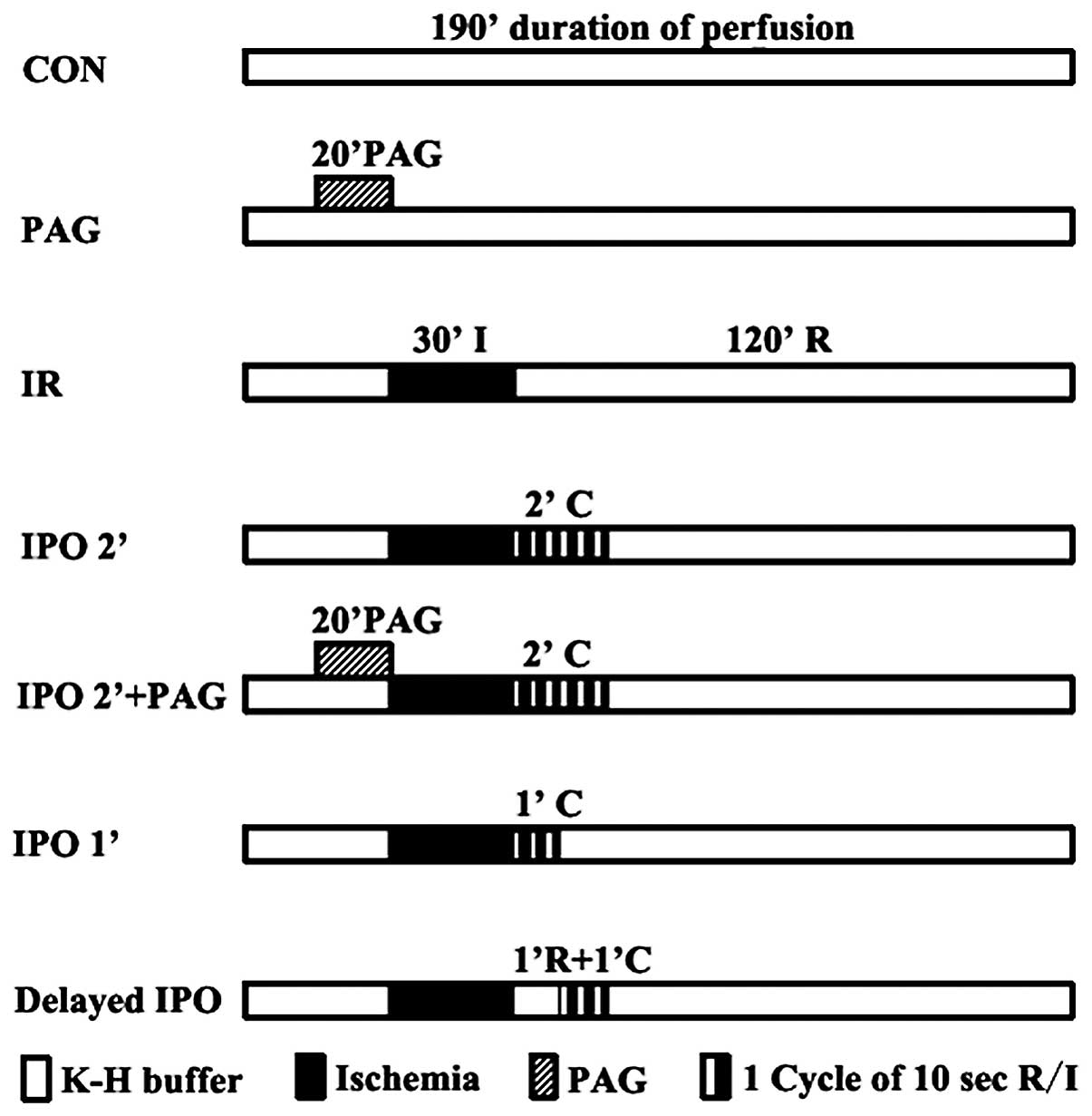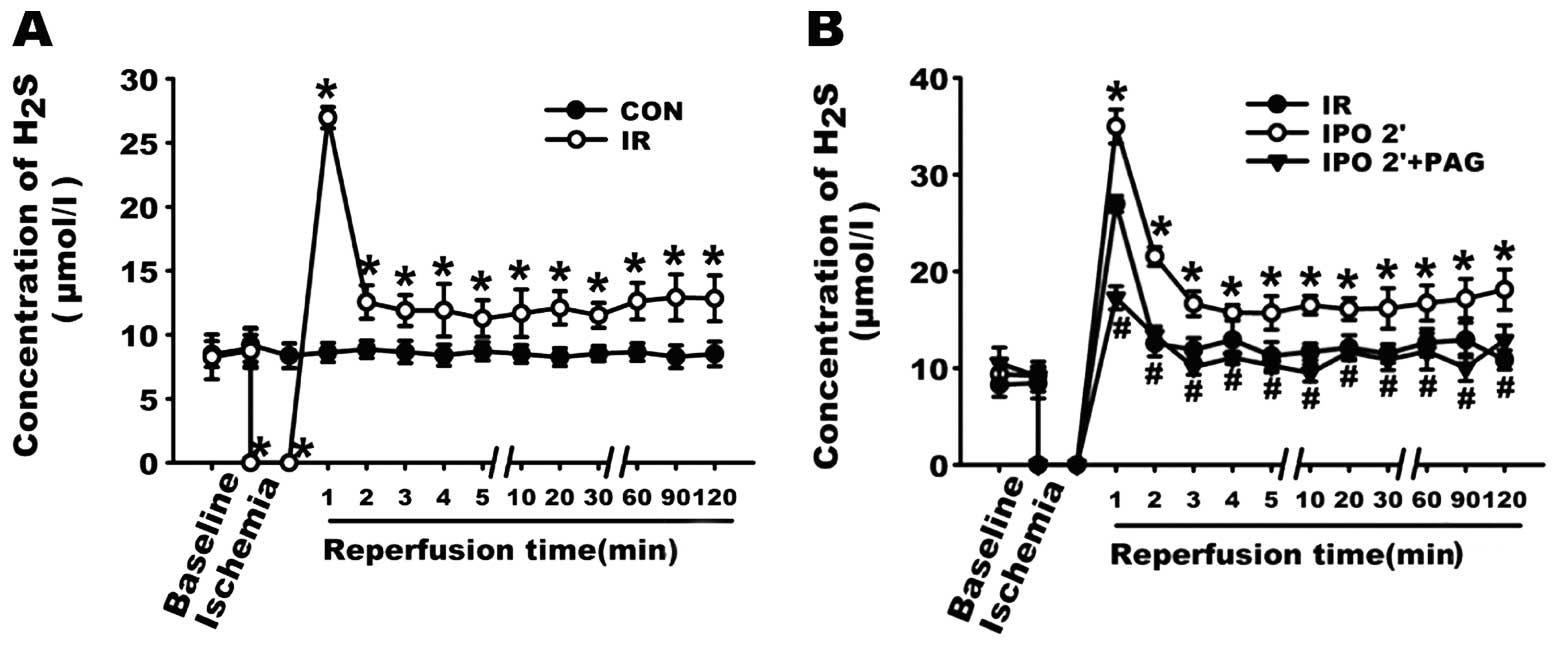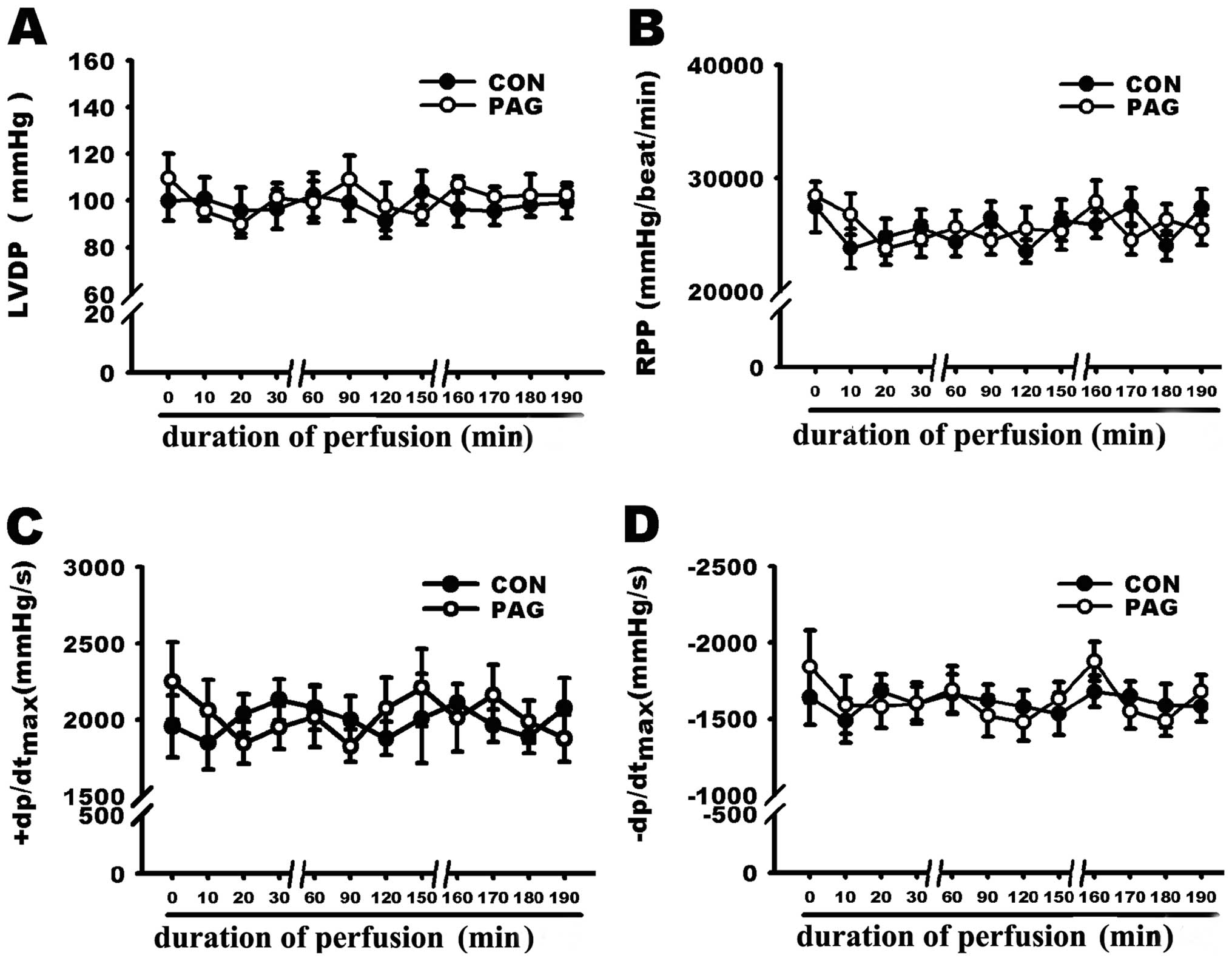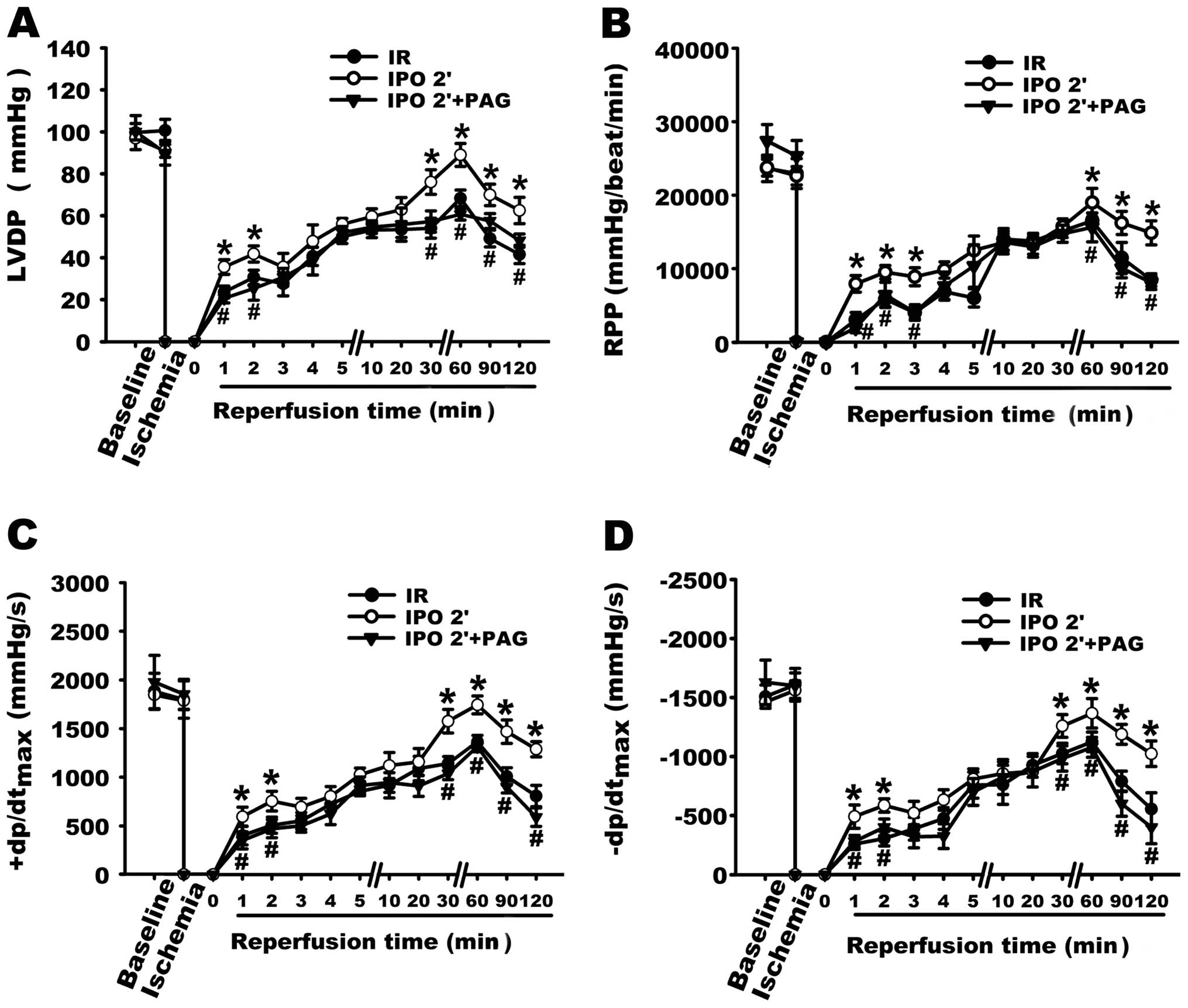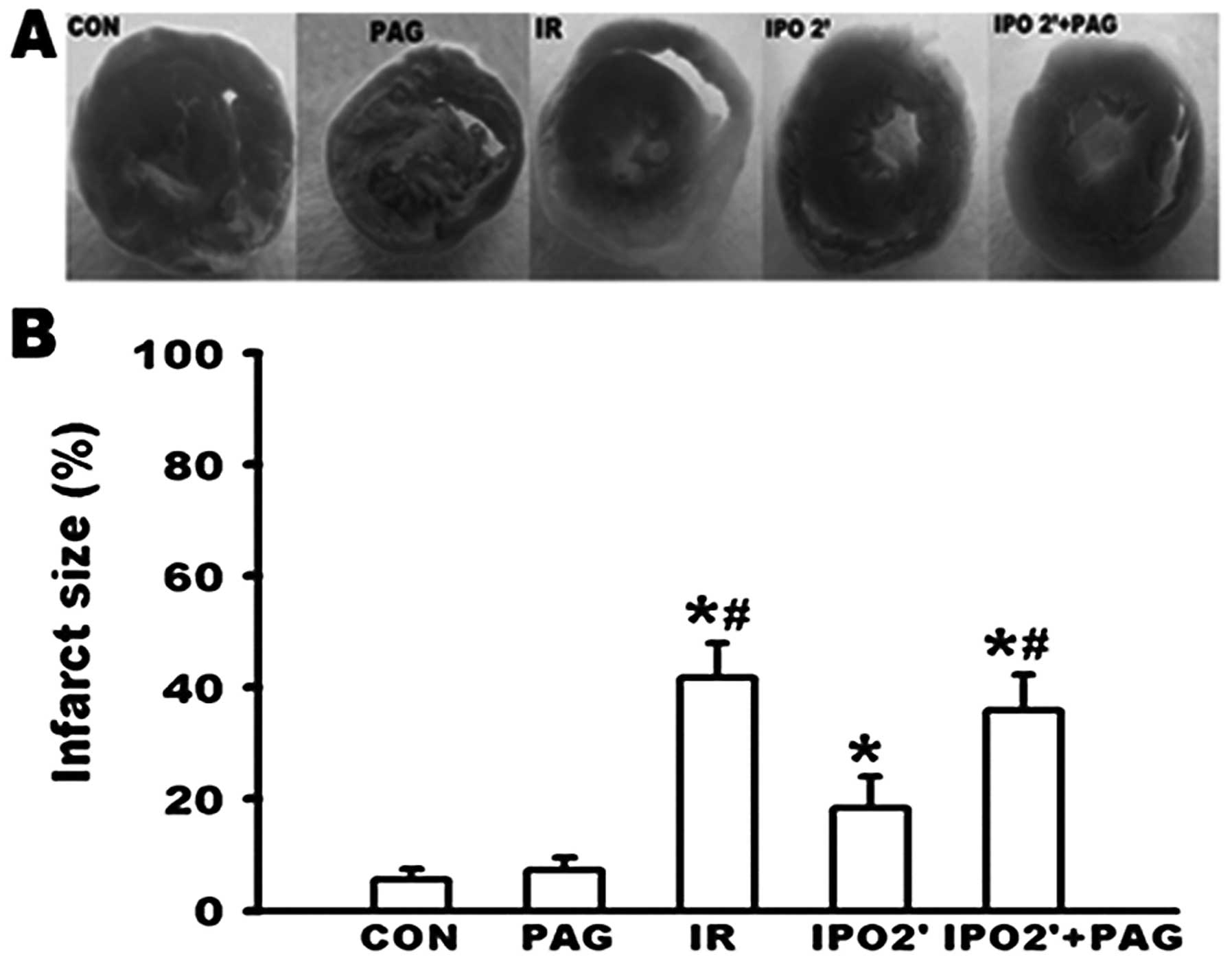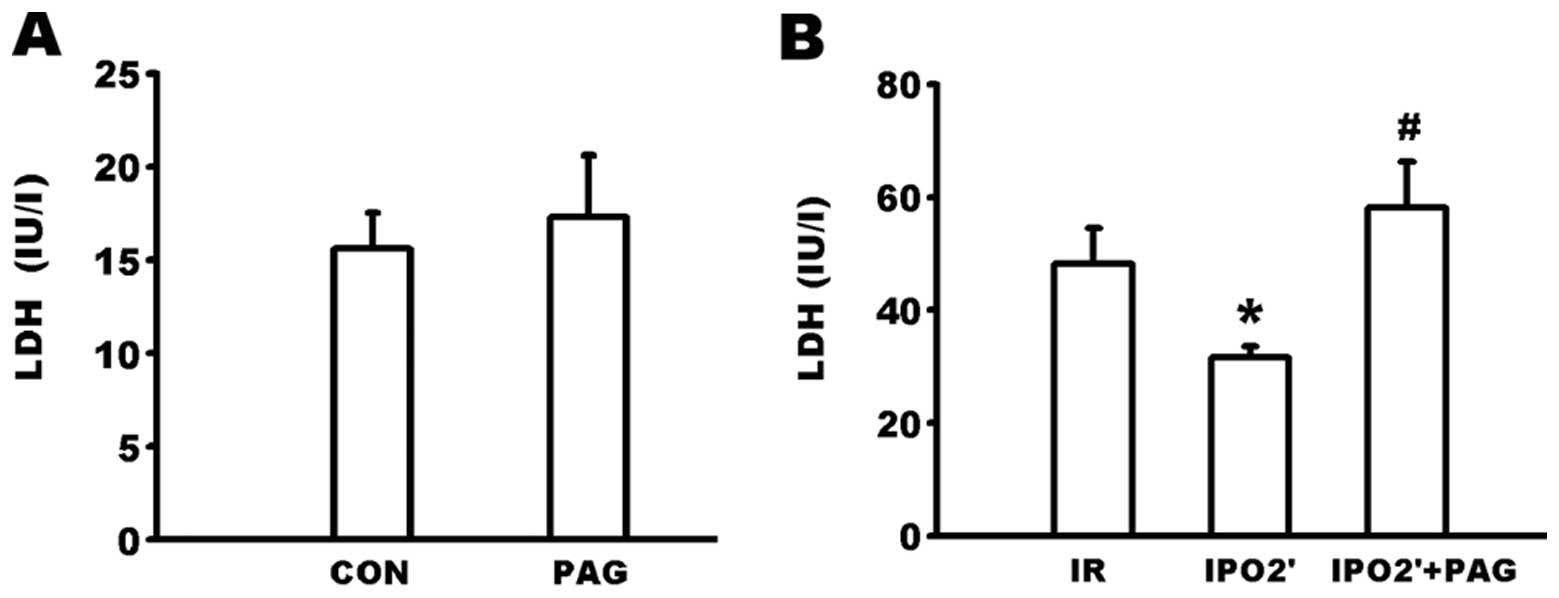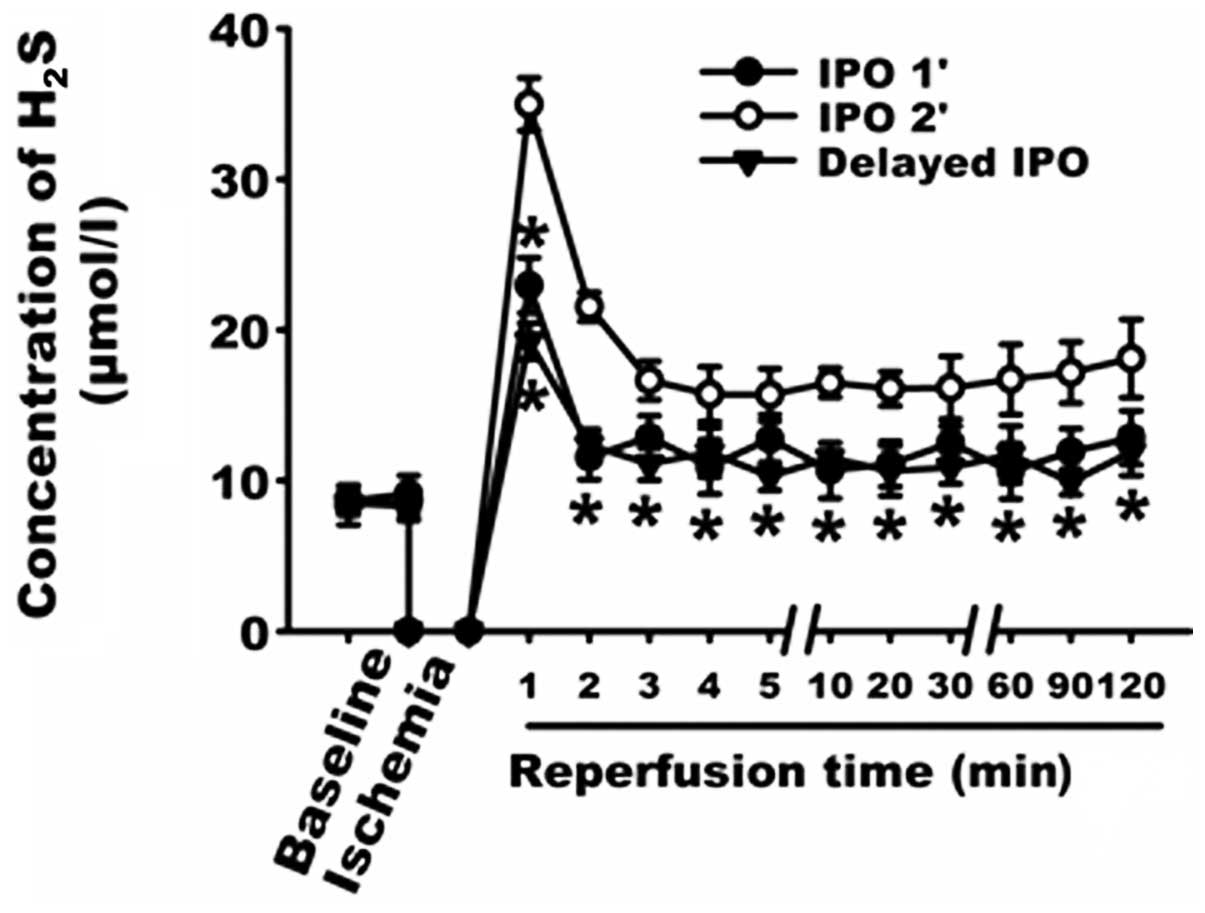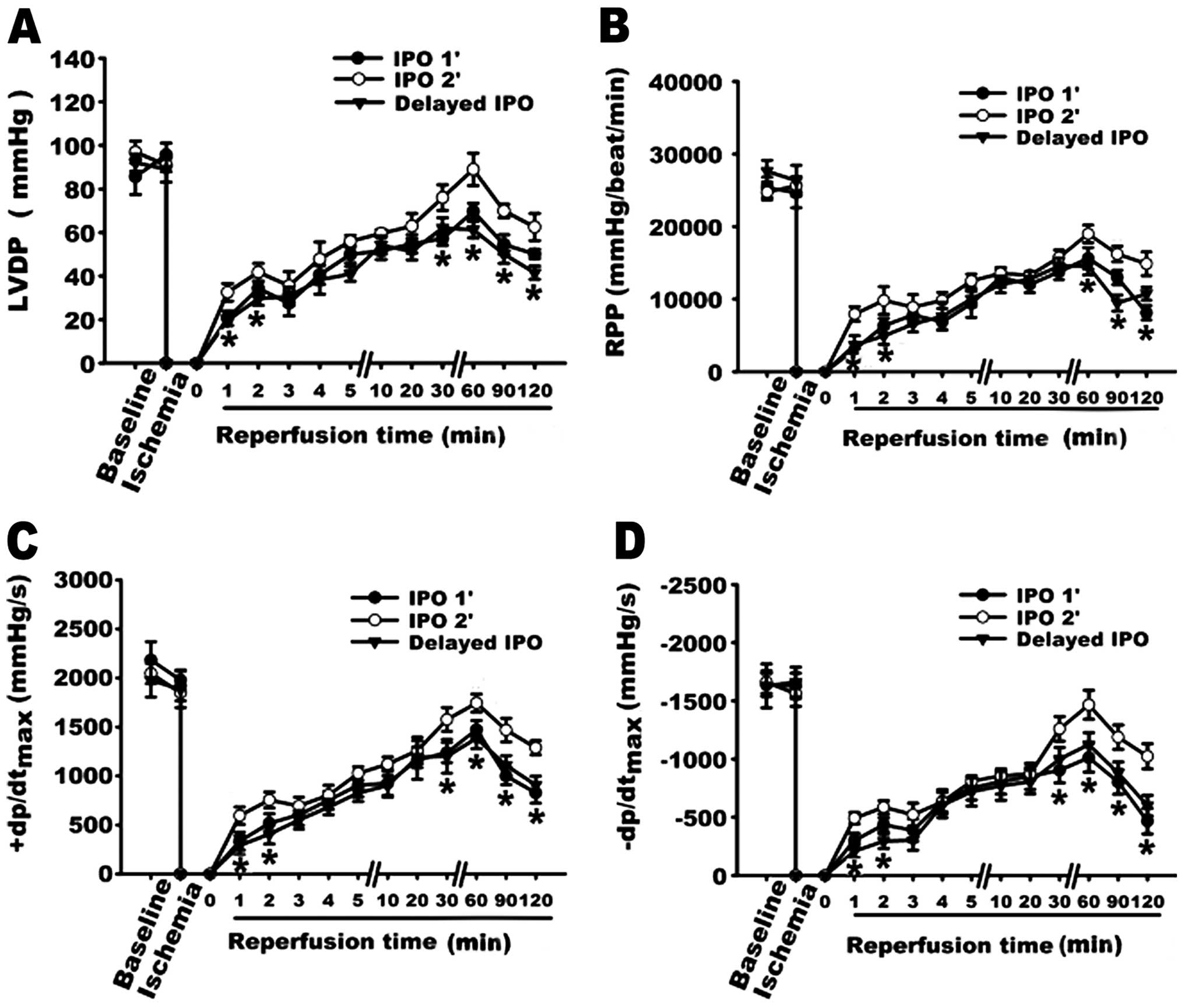|
1
|
Na HS, Kim YI, Yoon YW, Han HC, Nahm SH
and Hong SK: Ventricular premature beat-driven intermittent
restoration of coronary blood flow reduces the incidence of
reperfusion-induced ventricular fibrillation in a cat model of
regional ischemia. Am Heart J. 132:78–83. 1996. View Article : Google Scholar
|
|
2
|
Zhao ZQ, Corvera JS, Halkos ME, et al:
Inhibition of myocardial injury by ischemic postconditioning during
reperfusion: comparison with ischemic preconditioning. Am J Physiol
Heart Circ Physiol. 285:H579–588. 2003. View Article : Google Scholar : PubMed/NCBI
|
|
3
|
Kin H, Zhao ZQ, Sun HY, et al:
Postconditioning attenuates myocardial ischemia-reperfusion injury
by inhibiting events in the early minutes of reperfusion.
Cardiovasc Res. 62:74–85. 2004. View Article : Google Scholar : PubMed/NCBI
|
|
4
|
Cohen MV, Yang XM and Downey JM: The pH
hypothesis of postconditioning: staccato reperfusion reintroduces
oxygen and perpetuates myocardial acidosis. Circulation.
115:1895–1903. 2007. View Article : Google Scholar : PubMed/NCBI
|
|
5
|
Hausenloy DJ, Duchen MR and Yellon DM:
Inhibiting mitochondrial permeability transition pore opening at
reperfusion protects against ischaemia-reperfusion injury.
Cardiovasc Res. 60:617–625. 2003. View Article : Google Scholar
|
|
6
|
Sun HY, Wang NP, Kerendi F, et al: Hypoxic
postconditioning reduces cardiomyocyte loss by inhibiting ROS
generation and intracellular Ca2+ overload. Am J Physiol
Heart Circ Physiol. 288:H1900–1908. 2005. View Article : Google Scholar : PubMed/NCBI
|
|
7
|
Wang R: Two’s company, three’s a crowd:
can H2S be the third endogenous gaseous transmitter?
Faseb J. 16:1792–1798. 2002.
|
|
8
|
Szabo C: Hydrogen sulphide and its
therapeutic potential. Nat Rev Drug Discov. 6:917–935. 2007.
View Article : Google Scholar : PubMed/NCBI
|
|
9
|
Geng B, Yang J, Qi Y, et al:
H2S generated by heart in rat and its effects on cardiac
function. Biochem Biophys Res Commun. 313:362–368. 2004.
|
|
10
|
Zhao W, Zhang J, Lu Y and Wang R: The
vasorelaxant effect of H(2)S as a novel endogenous gaseous K(ATP)
channel opener. Embo J. 20:6008–6016. 2001. View Article : Google Scholar : PubMed/NCBI
|
|
11
|
Yong QC, Pan TT, Hu LF and Bian JS:
Negative regulation of beta-adrenergic function by hydrogen
sulphide in the rat hearts. J Mol Cell Cardiol. 44:701–710. 2008.
View Article : Google Scholar : PubMed/NCBI
|
|
12
|
Geng B, Chang L, Pan C, et al: Endogenous
hydrogen sulfide regulation of myocardial injury induced by
isoproterenol. Biochem Biophys Res Commun. 318:756–763. 2004.
View Article : Google Scholar : PubMed/NCBI
|
|
13
|
Elrod JW, Calvert JW, Morrison J, et al:
Hydrogen sulfide attenuates myocardial ischemia-reperfusion injury
by preservation of mitochondrial function. Proc Natl Acad Sci USA.
104:15560–15565. 2007. View Article : Google Scholar : PubMed/NCBI
|
|
14
|
Johansen D, Ytrehus K and Baxter GF:
Exogenous hydrogen sulfide (H2S) protects against
regional myocardial ischemiareperfusion injury - evidence for a
role of K ATP channels. Basic Res Cardiol. 101:53–60. 2006.
|
|
15
|
Sivarajah A, McDonald MC and Thiemermann
C: The production of hydrogen sulfide limits myocardial ischemia
and reperfusion injury and contributes to the cardioprotective
effects of preconditioning with endotoxin, but not ischemia in the
rat. Shock. 26:154–161. 2006. View Article : Google Scholar : PubMed/NCBI
|
|
16
|
Zhu YZ, Wang ZJ, Ho P, et al: Hydrogen
sulfide and its possible roles in myocardial ischemia in
experimental rats. J Appl Physiol. 102:261–268. 2007. View Article : Google Scholar : PubMed/NCBI
|
|
17
|
Yong QC, Lee SW, Foo CS, Neo KL, Chen X
and Bian JS: Endogenous hydrogen sulphide mediates the
cardioprotection induced by ischemic postconditioning. Am J Physiol
Heart Circ Physiol. 295:H1330–H1340. 2008. View Article : Google Scholar : PubMed/NCBI
|
|
18
|
Morrison RR, Talukder MA, Ledent C and
Mustafa SJ: Cardiac effects of adenosine in A(2A) receptor knockout
hearts: uncovering A(2B) receptors. Am J Physiol Heart Circ
Physiol. 282:H437–H444. 2002. View Article : Google Scholar : PubMed/NCBI
|
|
19
|
Bian JS, Yong QC, Pan TT, et al: Role of
hydrogen sulfide in the cardioprotection caused by ischemic
preconditioning in the rat heart and cardiac myocytes. J Pharmacol
Exp Ther. 316:670–678. 2006. View Article : Google Scholar : PubMed/NCBI
|
|
20
|
Zhu YZ, Chong CL, Chuah SC, et al:
Cardioprotective effects of nitroparacetamol and paracetamol in
acute phase of myocardial infarction in experimental rats. Am J
Physiol Heart Circ Physiol. 290:H517–H524. 2006. View Article : Google Scholar : PubMed/NCBI
|
|
21
|
Darling CE, Jiang R, Maynard M, Whittaker
P, Vinten-Johansen J and Przyklenk K: Postconditioning via
stuttering reperfusion limits myocardial infarct size in rabbit
hearts: role of ERK1/2. Am J Physiol Heart Circ Physiol.
289:H1618–1626. 2005. View Article : Google Scholar : PubMed/NCBI
|
|
22
|
Yang XM, Philipp S, Downey JM and Cohen
MV: Postconditioning’s protection is not dependent on circulating
blood factors or cells but involves adenosine receptors and
requires PI3-kinase and guanylyl cyclase activation. Basic Res
Cardiol. 100:57–63. 2005.
|
|
23
|
Crisostomo PR, Wang M, Wairiuko GM,
Terrell AM and Meldrum DR: Postconditioning in females depends on
injury severity. J Surg Res. 134:342–347. 2006. View Article : Google Scholar : PubMed/NCBI
|
|
24
|
Fantinelli JC and Mosca SM: Comparative
effects of ischemic pre and postconditioning on
ischemia-reperfusion injury in spontaneously hypertensive rats
(SHR). Mol Cell Biochem. 296:45–51. 2007. View Article : Google Scholar : PubMed/NCBI
|
|
25
|
Kin H, Zatta AJ, Lofye MT, et al:
Postconditioning reduces infarct size via adenosine receptor
activation by endogenous adenosine. Cardiovasc Res. 67:124–133.
2005. View Article : Google Scholar : PubMed/NCBI
|
|
26
|
Zhu M, Feng J, Lucchinetti E, et al:
Ischemic postconditioning protects remodeled myocardium via the
PI3K-PKB/Akt reperfusion injury salvage kinase pathway. Cardiovasc
Res. 72:152–162. 2006. View Article : Google Scholar : PubMed/NCBI
|
|
27
|
Wang HC, Zhang HF, Guo WY, et al: Hypoxic
postconditioning enhances the survival and inhibits apoptosis of
cardiomyocytes following reoxygenation: role of peroxynitrite
formation. Apoptosis. 11:1453–1460. 2006. View Article : Google Scholar
|
|
28
|
Dombkowski RA, Russell MJ and Olson KR:
Hydrogen sulfide as an endogenous regulator of vascular smooth
muscle tone in trout. Am J Physiol Regul Integr Comp Physiol.
286:R678–R685. 2004. View Article : Google Scholar : PubMed/NCBI
|
|
29
|
Penna C, Mancardi D, Rastaldo R, Losano G
and Pagliaro P: Intermittent activation of bradykinin B2 receptors
and mitochondrial KATP channels trigger cardiac postconditioning
through redox signaling. Cardiovasc Res. 75:168–177. 2007.
View Article : Google Scholar
|
|
30
|
Weihrauch D, Krolikowski JG, Bienengraeber
M, Kersten JR, Warltier DC and Pagel PS: Morphine enhances
isoflurane-induced postconditioning against myocardial infarction:
the role of phosphatidylinositol-3-kinase and opioid receptors in
rabbits. Anesth Analg. 101:942–949. 2005. View Article : Google Scholar
|
|
31
|
Whiteman M, Armstrong JS, Chu SH, et al:
The novel neuro-modulator hydrogen sulfide: an endogenous
peroxynitrite ‘scavenger’? J Neurochem. 90:765–768. 2004.PubMed/NCBI
|
|
32
|
Whiteman M, Cheung NS, Zhu YZ, et al:
Hydrogen sulphide: a novel inhibitor of hypochlorous acid-mediated
oxidative damage in the brain? Biochem Biophys Res Commun.
326:794–798. 2005. View Article : Google Scholar : PubMed/NCBI
|
|
33
|
Hassouna A, Matata BM and Galinanes M:
PKC-epsilon is upstream and PKC-alpha is downstream of mitoKATP
channels in the signal transduction pathway of ischemic
preconditioning of human myocardium. Am J Physiol Cell Physiol.
287:C1418–C1425. 2004. View Article : Google Scholar : PubMed/NCBI
|















